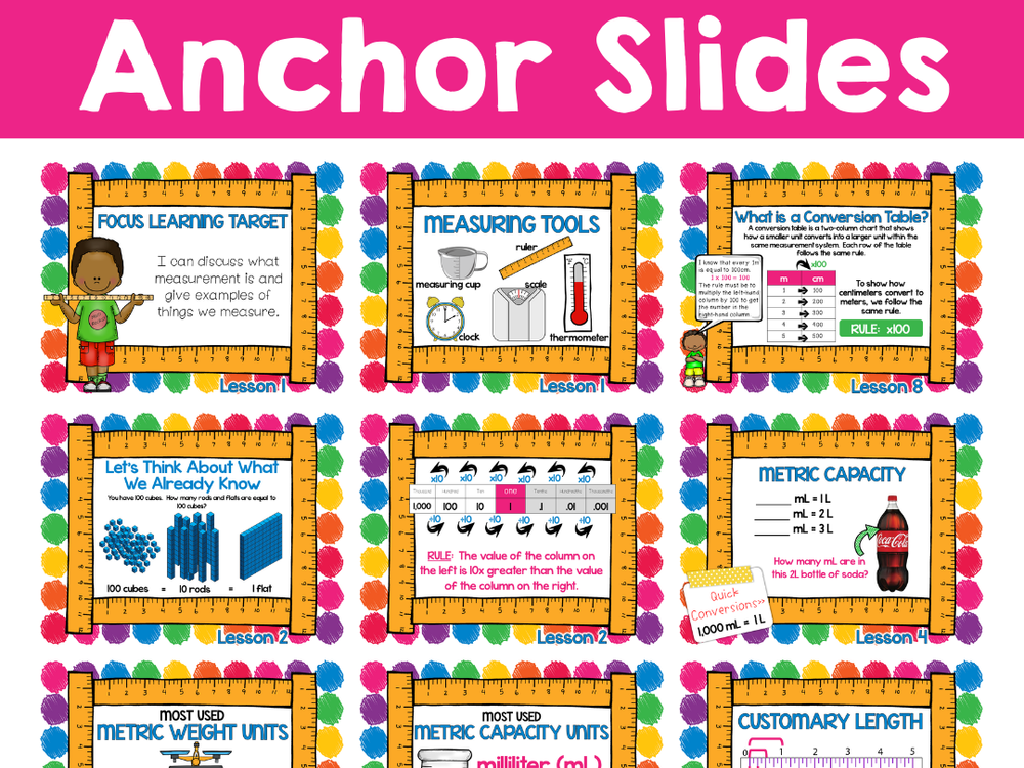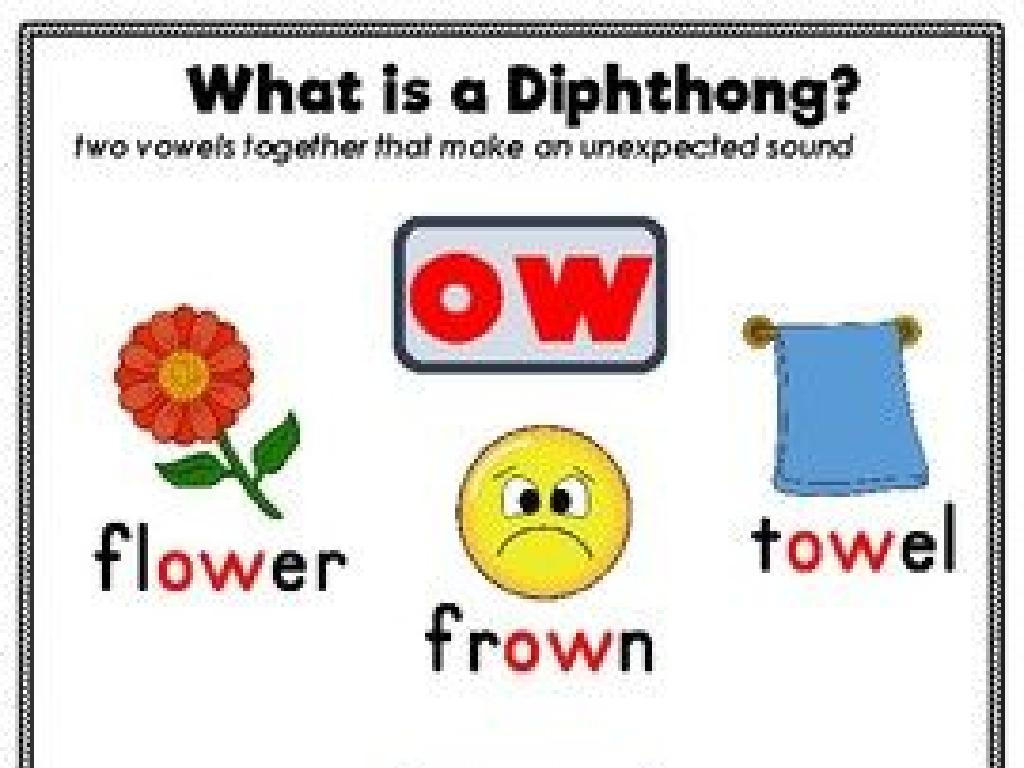Spell The Long O Word: Silent E, Oa, Ow, Old, Ost, Olt
Subject: Language arts
Grade: Third grade
Topic: Short And Long Vowels
Please LOG IN to download the presentation. Access is available to registered users only.
View More Content
Welcome to Long O Sounds!
– Learn about the long O sound
– The long O sounds like ‘oh’ as in ‘go’
– Explore spelling variations
– Silent e: ‘bone’, oa: ‘boat’, ow: ‘snow’, old: ‘gold’, ost: ‘post’, olt: ‘bolt’
– Practice with examples
– We’ll spell words together and use them in sentences
– Aim to master the long O
|
This slide introduces the concept of the long O sound and its various spellings to third-grade students. Start by explaining the sound itself, and then discuss each spelling variation, providing examples for each. Engage the students with practice exercises where they spell words and use them in sentences, reinforcing their understanding. By the end of the lesson, students should feel confident in identifying and spelling words with the long O sound. Encourage participation and praise efforts to create a positive learning environment.
Exploring the Long O Sound
– What is a Long O sound?
– It’s the ‘O’ as in ‘go’ or ‘no’.
– Long O vs. Short O
– Unlike ‘o’ in ‘pot’ or ‘top’.
– Examples of Long O words
– Words like ‘bone’, ‘coat’, ‘blow’, ‘cold’, ‘post’, ‘bolt’.
– Practice listening to Long O
– We’ll listen to words and identify the Long O.
|
This slide introduces the concept of the Long O sound to third-grade students. Begin by explaining that the Long O sound is similar to the name of the letter ‘O’ itself, as heard in words like ‘go’ and ‘no’. Contrast this with the Short O sound, which is the ‘o’ heard in words like ‘pot’ and ‘top’. Provide clear examples of Long O words, using the silent e, oa, ow, old, ost, and olt patterns. Engage the class by listening to these words in a fun activity to help them identify and differentiate the Long O sound. Encourage students to repeat the words after you to practice the correct pronunciation.
The Magic of Silent E with Long O
– Silent E makes O say its name
– ‘hop’ turns into ‘hope’
– The ‘e’ at the end is silent but powerful
– Find words with silent E
– Think of ‘robe’ versus ‘rob’, and ‘cone’ versus ‘con’
– Practice spelling changes
|
This slide introduces the concept of the silent E and its role in changing the pronunciation of the letter O from a short vowel sound to a long vowel sound. Emphasize the ‘magic’ of the silent E and how it doesn’t make a sound itself but affects the vowel earlier in the word. Provide examples and encourage students to come up with their own, reinforcing the rule by comparing word pairs where the only difference is the presence of the silent E. During the next class, have a spelling bee or a matching game where students transform short O words into long O words by adding a silent E.
The OA Team: Mastering the Long O Sound
– ‘OA’ letters work as a team
– ‘OA’ says ‘O’ as in ‘boat’
– Examples: ‘boat’, ‘coat’
– More ‘oa’ words: ‘road’, ‘toad’, ‘load’
– Practice with ‘oa’ words
– Find ‘oa’ words in books or signs
|
This slide introduces the concept of vowel teams, specifically focusing on the ‘OA’ team, which is used to represent the long ‘O’ sound in words. Use examples like ‘boat’ and ‘coat’ to illustrate the sound. Encourage students to practice by identifying ‘oa’ words in their environment or in reading materials. This will help them recognize patterns in spelling and improve their reading fluency. During the next class, have a practice session where students can share the ‘oa’ words they found and use them in sentences to demonstrate their understanding.
The OW Duo: Spelling Long O Words
– ‘O’ pairs with ‘W’ to say ‘Ow’
– Examples: ‘snow’ and ‘bow’
– ‘Snow’ has ‘ow’ at the end, ‘bow’ has it in the middle
– ‘Ow’ can be in the middle or end
– Practice with different ‘ow’ words
– Find words in books or at home with ‘ow’ and spell them out
|
This slide focuses on the combination of the letters ‘O’ and ‘W’ to produce the long ‘O’ sound, as in ‘snow’ and ‘bow’. It’s important to show students that the ‘ow’ sound can appear at the end of words as well as in the middle. Encourage students to listen for this sound in words and to practice spelling by identifying ‘ow’ in various words they encounter in reading or in their environment. You can make this interactive by asking students to brainstorm words together and write them on the board, or by having them search for ‘ow’ words in a reading passage.
Exploring the Old, Ost, and Olt Families
– ‘Old’, ‘ost’, ‘olt’ have long O
– Words like ‘gold’, ‘sold’ share the ‘old’ sound
– Examples: ‘cold’, ‘most’, ‘bolt’
– ‘Frost’, ‘lost’ are in the ‘ost’ family
– Discover more family words
– ‘Jolt’, ‘volt’ fit with ‘bolt’ in ‘olt’ family
|
This slide introduces students to the word families ‘old’, ‘ost’, and ‘olt’, which all contain the long O sound. Start by explaining what word families are and how they can help with spelling and pronunciation. Provide the examples ‘cold’, ‘most’, and ‘bolt’ to illustrate the concept. Then, engage the students in an activity to find more words that belong to each family. Encourage them to think of words they have heard in stories or use in daily conversation. This activity will help them recognize patterns in spelling and sound, making it easier to read and spell new words in the future.
Class Activity: Long O Word Hunt
– Search for long O sounds
– Find objects or pictures
– Write the words on your worksheet
– Use your worksheet to record each word
– Spell words with long O correctly
– Remember the patterns: silent e, oa, ow, old, ost, olt
|
This activity is designed to help students recognize and spell words with the long O sound. Set up the classroom with various objects or pictures that include the long O sound. Encourage students to explore and find these items. Provide worksheets for students to write down the words they find, emphasizing correct spelling. Remind them of the different patterns that can make the long O sound, such as silent e (as in ‘bone’), oa (as in ‘boat’), ow (as in ‘snow’), old (as in ‘gold’), ost (as in ‘post’), and olt (as in ‘bolt’). After the hunt, review the words as a class and discuss the spelling patterns. This will reinforce their understanding of long O sounds and spelling rules.
Conclusion: Mastering the Long O Sound
– Celebrating our word hunt success
– Reviewing long O spellings
– silent e, oa, ow, old, ost, olt
– Practice leads to perfection
– Keep exploring words at home
– Try to find more long O words in your favorite books!
|
As we wrap up today’s lesson, congratulate the students on their hard work during the word hunt activity. Reinforce their understanding by reviewing the different ways to spell the long O sound, which includes silent e (as in ‘home’), oa (as in ‘boat’), ow (as in ‘snow’), old (as in ‘gold’), ost (as in ‘post’), and olt (as in ‘bolt’). Emphasize the importance of practice in mastering these spelling patterns. Encourage them to continue their learning outside of the classroom by finding and practicing long O words in books they enjoy reading at home. This will help solidify their understanding and make them more confident in their spelling abilities.
Homework Challenge: Long O Words
– Find five words with long O
– Write a sentence for each word
– Use words in context to show meaning
– Show understanding of word usage
– Share your sentences in class
– Practice speaking and listening skills
|
This homework task is designed to reinforce the students’ understanding of the long O sound in various word patterns. Encourage them to look for words that use the silent e, oa, ow, old, ost, and olt patterns. They should write creative sentences that clearly demonstrate the meaning of each word. This activity will help them not only recognize the long O sound in different contexts but also enhance their vocabulary and sentence construction skills. In the next class, create a supportive environment where students can share their sentences and receive constructive feedback. This will also serve as a great opportunity for peer learning.






